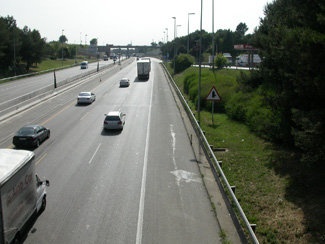How did heavy metal get to the road?

Roadside sediments, in which high amounts of sediments have been detected, are an environmental concern of great interest due to the possible transmission of their pollutants from traffic activities and road maintenance to humans and environment. This work analyzes leaching tests applied to roadside metallic sediments, in order to assess them and compare them with heavy metals remobilization by fractionation.
Among the environmental concerns of recent years, roadside sediments are of great interest due to the possible transmission of their pollutants from traffic activities and road maintenance to humans and environment, posing thus a risk to environmental and human health.
High amounts of metals have been detected in these sediments, and their origin is linked to the combustion processes of vehicles, road surface degradation, application of road maintenance chemicals such as deicing salts, wearing of vehicles, and wearing of signposts and crash barriers.
Pollution from these sources is emitted in a particulate form and, depending on climatic conditions, the coarsest particles may accumulate immediately at the asphalt border, mixing with natural components, and forming roadside deposited sediments (RDS). The metals pollution decreases in concentration with depth and with distance from the roadway.
From the environmental forensic point of view, the pollutant charge of roadside sediments can be easily characterized, related to nonpoint source pollution, and connected to vehicles emissions, thus acting as environmental registries of valuable information.
Among the metals considered to pollute roadside sediments, we highlight Pb mostly produced by the combustion of former leaded fuels, Zn contained in ZnO used in the rubber compound for tires as a vulcanising agent and also in crash barriers, Cu as a component of brake linings and in many alloys present in cars, and Cd found in tires or in lubricating soils that can be spilled as a result of accidents.
Density. Highway C-58 is transited by more of 100.000 vehicles per day.
In the present work, deposited pollution in roadside sediments has been assessed by sampling along a highly travelled highway in Barcelona and the surrounding area (C-58). The available amounts of the heavy metals were determined by applying different leaching tests and calculating the concentration enrichment ratio (CER) and the environmental concentration guideline values (ECG). To gain information on the heavy metals (HMs) fractionation, the sequential extraction scheme (SES), established by the Standard Measurement and Testing (SM&T), was implemented, and the results were compared with those obtained by single leaching tests.
An anthropogenic enhancement of Zn, Pb and Cu has been observed, while a minimum anthropogenic apportion for metals such as Cd, Cr, and Ni has been detected. The information obtained in this study has identified hazardous areas that need a remedial strategy.
References
"Avaluació de la remobilització de metalls mitjançant el fraccionament. Comparació de tests d'extracció aplicats a sediments dipositats al llindar de l'autopista". Pérez, Gustavo; López-Mesas, Montserrat; Valiente, Manuel. ENVIRONMENTAL SCIENCE & TECHNOLOGY, 42 (7): 2309-2315 APR 1 2008.


